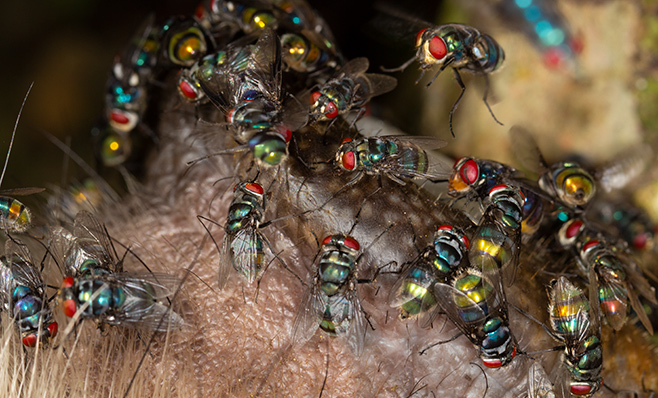|
Family: Calliphoridae (blowflies)
Life
> Eukaryotes >
Opisthokonta >
Metazoa (animals) > Bilateria > Ecdysozoa
> Panarthropoda > Tritocerebra > Phylum:
Arthopoda > Mandibulata >
Atelocerata > Panhexapoda >
Hexapoda
> Insecta (insects) > Dicondyla > Pterygota >
Metapterygota > Neoptera > Eumetabola > Holometabola > Panorpida > Antliophora
> Diptera (flies) >
Brachycera
> Muscomorpha > Eremoneura > Cyclorrapha
> Schizophora > Oestroidea
 |
|
Calliphorid flies on dead Bushpig carcass, Amatole Hiking Trail, Eastern Cape. [photo Hamish Robertson] |
Flies of the family Calliphoridae often have shiny, metallic
colouration so that they are known as greenbottles or bluebottles.
However, the more regularly used common name for members of this family is
blowfly, a name that arose because when their larvae (termed maggots) infest meat
they render it
"flyblown" making it unfit to eat. Feeding activity by the maggots causes putrefaction, resulting in the production of gases that give the meat a
blown up appearance. Calliphorids are among the first flies to find freshly dead animals and lay their eggs on them, which hatch into maggots that feed on the flesh. Lucilia cuprina is one of the most common species and is highly adaptable, being not only attracted to dead animals but also to live animals that have vulnerable areas such as wounds or the area around the rear end of the animal (a problem particularly in sheep). Larvae of Lucilia cuprina can also thrive in any moist, rotting organic matter so are a problem in urban refuse. A total of 61 species of calliphorids are known from South Africa (SA Animal Checklist).
Text by Margie Cochrane and Hamish Robertson |
